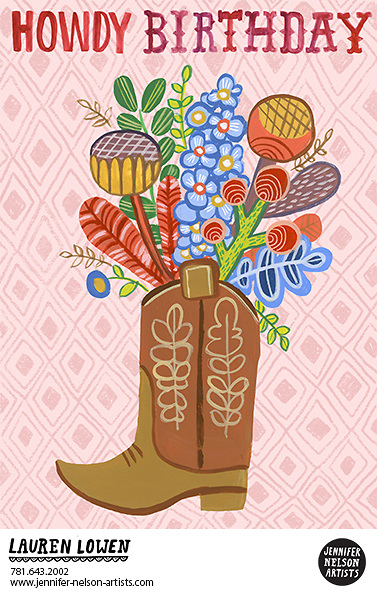A long time ago (ok, not THAT long ago) I found myself pondering the same conundrum many artists do at some point (or at many points) in their lives. The question was how should I actually make my art? Hand-done with my trusty gouache or with the magic box known as the computer? And - OH - the stress! You would think I was making the most important decision in my life. Truly, it would drive me bonkers at times.
Years ago, I was pretty much doing 95% of my work with paint. Sure, I had some Adobe Photoshop and Illustrator savvy; I had even done some client work that was all-digital to test the waters, but I was still definitely not what I would consider a “digital artist” at this point. Even more frustrating was that my work was so flat and smooth that most people thought my gouache paintings were actually digital! It seemed to make sense that I graduate to the all mighty vector and join the modern age. In addition, my software know-how had expanded tenfold while working as an in-house designer, making me a digital ninja that could execute my work at a new level. So when I had the chance to bust out some vector work for an online class, I thought this would certainly be the turning point. My new era had begun! So I made the new piece and low and behold… I didn’t care for it that much. Sure, I probably was getting used to this new “look,” you say. However, It wasn’t that. I realized that the vector process had completely stripped away the elements that made my work look like me. As much as I tried to make my early gouache paintings super neat and smooth, I realized when comparing it to the vector piece that I actually liked all the little mistakes that happened during the painting process – the texture of my brush, the lines that would vary and have funky edges. The vector work was just too perfect for me!
In college, my peers and instructors knew me as someone who was pretty confident in mark-making. My sketchbook overflowed with drawings and doodles that had energy and a wonderful messiness. I loved a good two-minute life drawing pose executed with sumi ink on a large drawing pad. Although my final projects were executed with skill, there was always something in them that was missing when compared to my sketches. Like many artists out there, I would tighten up and the freeness of my original hand would be lost to some degree. If I could just figure out how to keep the original liveliness of these sketches in my final pieces!
Naturally, I believed the solution was to work digitally. There I could preserve my sketches and work on top of them, instead of trying to emulate or duplicate them under pressure. The growing popularity of vector work out there made me believe that Adobe Illustrator and vector surely was the ideal answer, and I believed that once I started this new art chapter of my life, it would just be vector, vector, vector and I would never look back.
Oh, how wrong I was.
Fast forward to that previously mentioned vector piece for my online class. As much as I was disappointed, this process made a light bulb go off. It confirmed that I liked the texture and organic quality of paint; that I should embrace it. So instead of trying to make my future gouache paintings super perfect, I felt more confident to explore the range I could get with the medium. My process became more relaxed and exploratory as I combined loose watercolor techniques with graphic elements. And as I continued to grow my digital knowledge at my designer position, I decided that I didn’t have to choose one method. Instead, I could start to combine techniques I love in order to create a unique vision. Instead of picking one or the other, I started to paint elements and combine them with digital components. Brush strokes were scanned in and then I’d add even more texture with my sturdy Wacom tablet. Gouache paintings were married with digitally colored ink drawings in Photoshop.
I love telling people that the computer made me a better painter, and painting made me a better digital artist.
Both have their unique advantages, and I find that bouncing between the two helps to improve and grow my skills, much like one might exercise their lower body one day and their upper body the next. The notion that artists and designers need to pick one medium or method is slightly absurd when you think about it, as it only serves to limit creativity and expression (which is the complete opposite of what art encourages). Each one serves the other as I discover knew digital things and think “gee, what if I tried that when painting?” Or maybe I draw something that I love and am challenged to continue experimenting with it on the computer without fear of ruining it.
In addition, there are some nice benefits to this way of working. I now have a range of skills that allow me to make pieces that are custom to my clients’ needs. It also allows me to use all my strengths and not feel limited when I try something new.
So, dear reader… I encourage you to explore! Get messy! Be fearless! Discover new skills and do so in the name of creative delight! Your artistic flavor is as unique as the way you dress or your sense of humor. It should be rich and complex! Just like each one of us.




